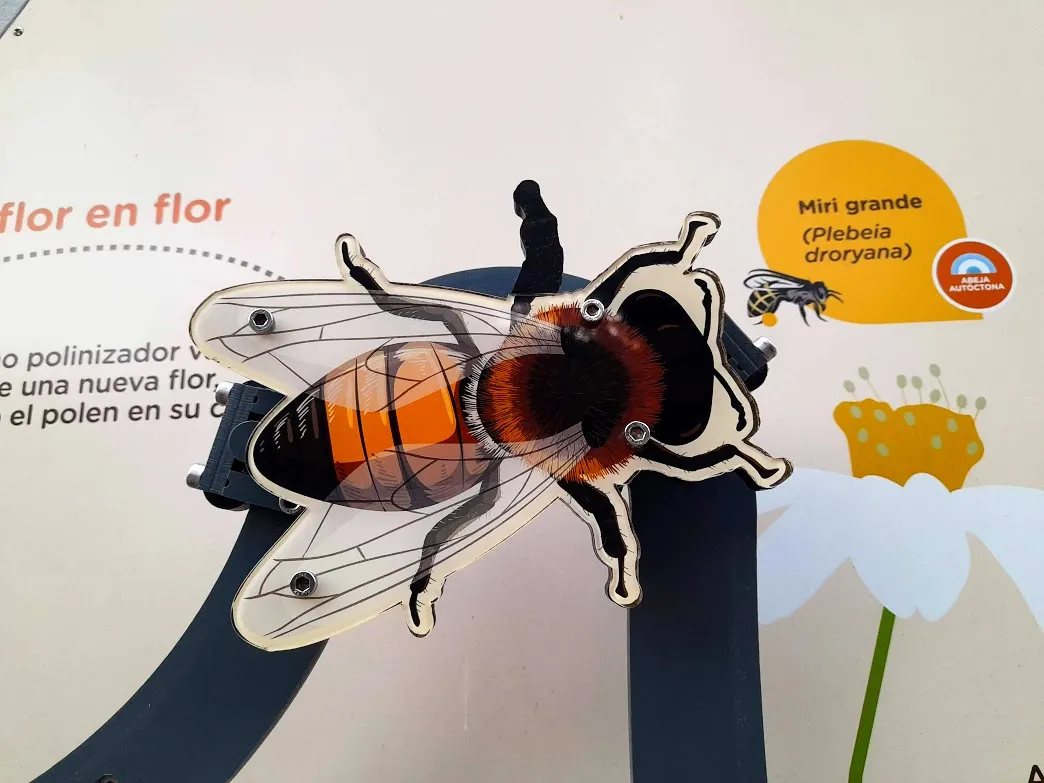
En la última visita que hice al Ecoparque de Buenos Aires, no podía dejar, desapercibido, un espacio que ha sido construido, para que tanto los niños, como los adultos, tengan la oportunidad de conocer todo sobre polinización, cuidados y beneficios de las abejas, y de otros insectos.
He colocado como título “Conociendo la polinización, a través del juego interactivo”, pues esa es una de las estrategias más efectivas a la hora de impartir algún tipo de enseñanza. En este caso, tanto niños como adultos, pueden intercambiar roles, y ejercerlos también. Mientras juegan se activan todos esos conocimientos previos, sobre todo los que tal vez estaban errados y que gracias a esta actividad, lograrían aclarar y aprender.
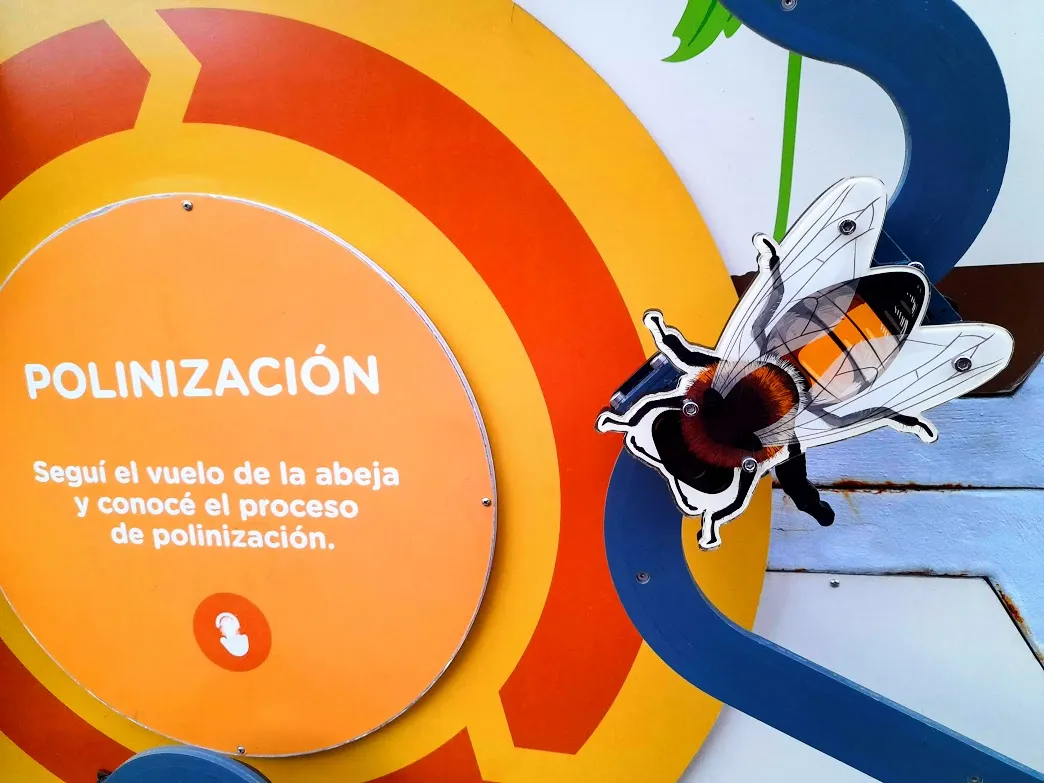
Se trata de un panal gigante, donde cada persona puede participar llevando de la mano a una de las abejas para hacer el recorrido de la polinización real. La estructura está hecha para que se facilite el proceso y la interacción en todos los que deseen aprender. Paso a explicar cada una de las imágenes y la estrategia para llevar a quien lo juega, al logro del aprendizaje cognitivo.
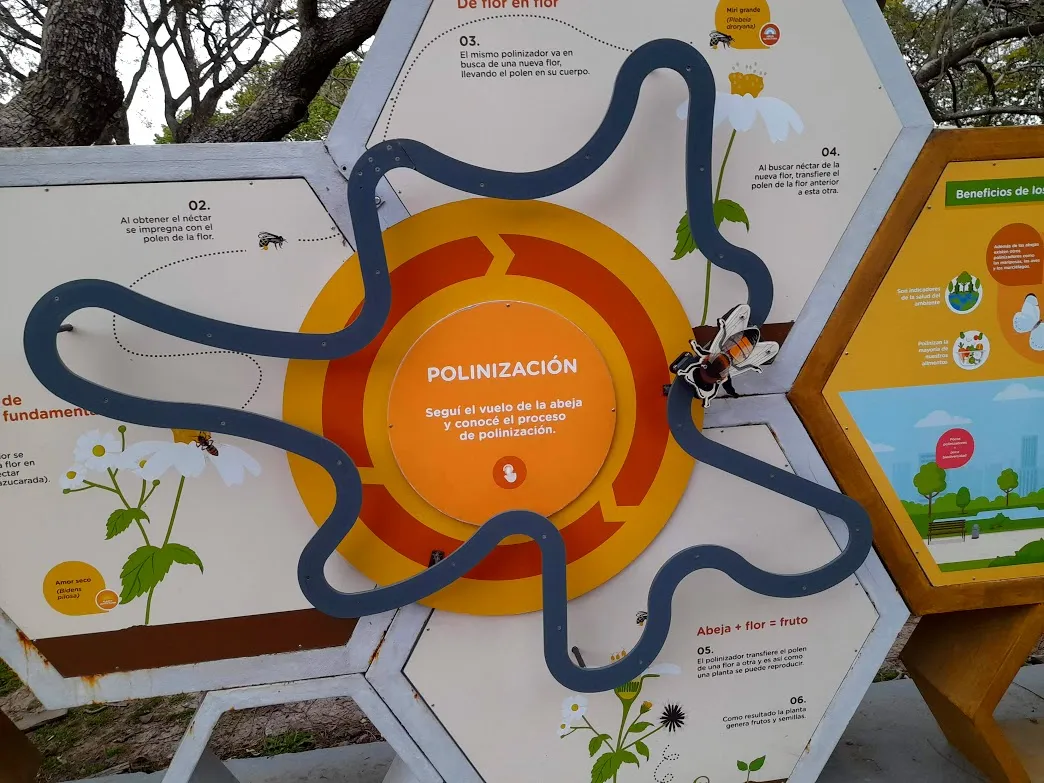
En la imagen siguiente, se observa el tamaño de la abeja guía del juego. Con ella se hará el recorrido, paso a paso, hasta llegar a culminar este proceso.
Paso 1: El polinizador se acerca hasta la flor que contiene el néctar
Paso 2: Cuando obtiene el néctar, esta se impregna con el polen de la flor.
Paso 3:Continúa su recorrido de flor en flor, llevando su cuerpo lleno de polen.
Paso 4: Al llevar el polen en su cuerpo, cuando pasa a la siguiente flor, la impregna de polen igualmente.
Paso 5: En este intercambio de, polen, el polinizador, al transferir el polen de una flor a otra, logra que la planta se pueda reproducir.
Paso 6: El éxito de este proceso de polinización es que finalmente las plantas pueden generar sus frutos y semillas.
Pues bien, hasta este tramo, culmina una parte del juego. Como queda demostrado, es una estrategia que va a llevar a la persona a lograr un aprendizaje “significativo”. Además de lograr internalizar la importancia de la labor de las abejas y otros insectos al realizar este trabajo tan necesario para el equilibrio del ecosistema planetario.
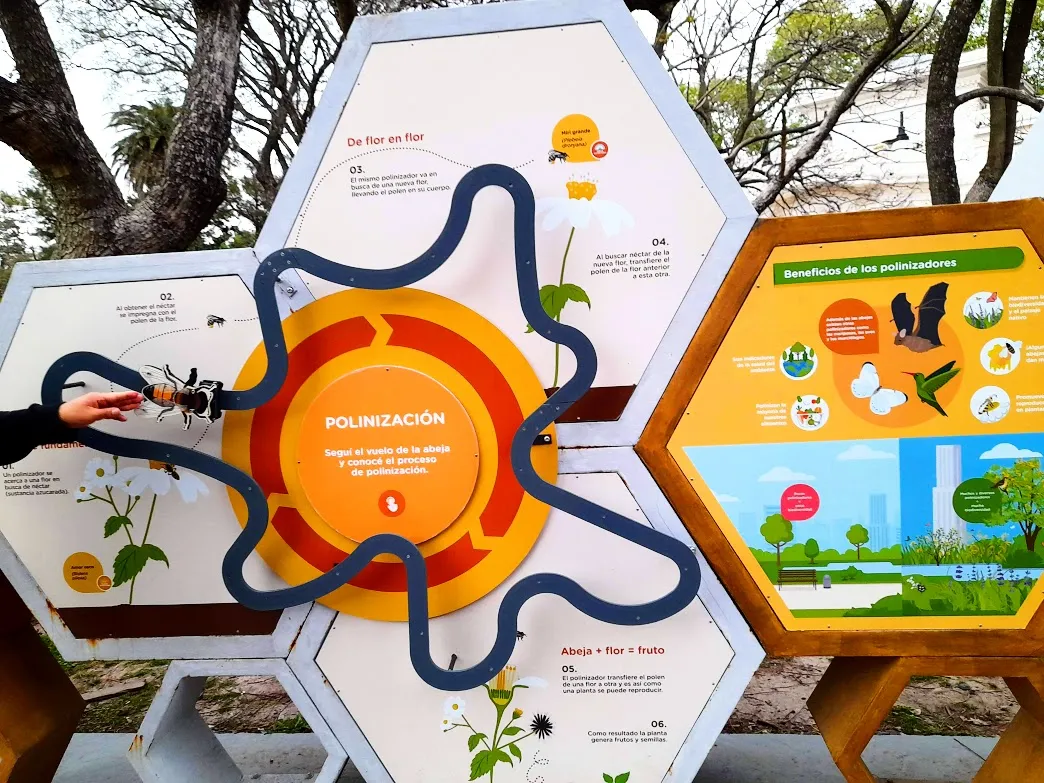
El siguiente aspecto a tratar dentro del mismo juego, son los beneficios de los polinizadores. Como sabemos y aquí lo explican con ilustraciones, no solo las abejas son polinizadores. En la parte inferior de esta imagen representan con dos paisajes, lo que significa las consecuencias de la no polinización, como la poca biodiversidad y menor cantidad de polinizadores. Ahora lo que ocurre cuando se deja a la naturaleza actuar con libertad, pues, hay muchos polinizadores y abundante biodiversidad.
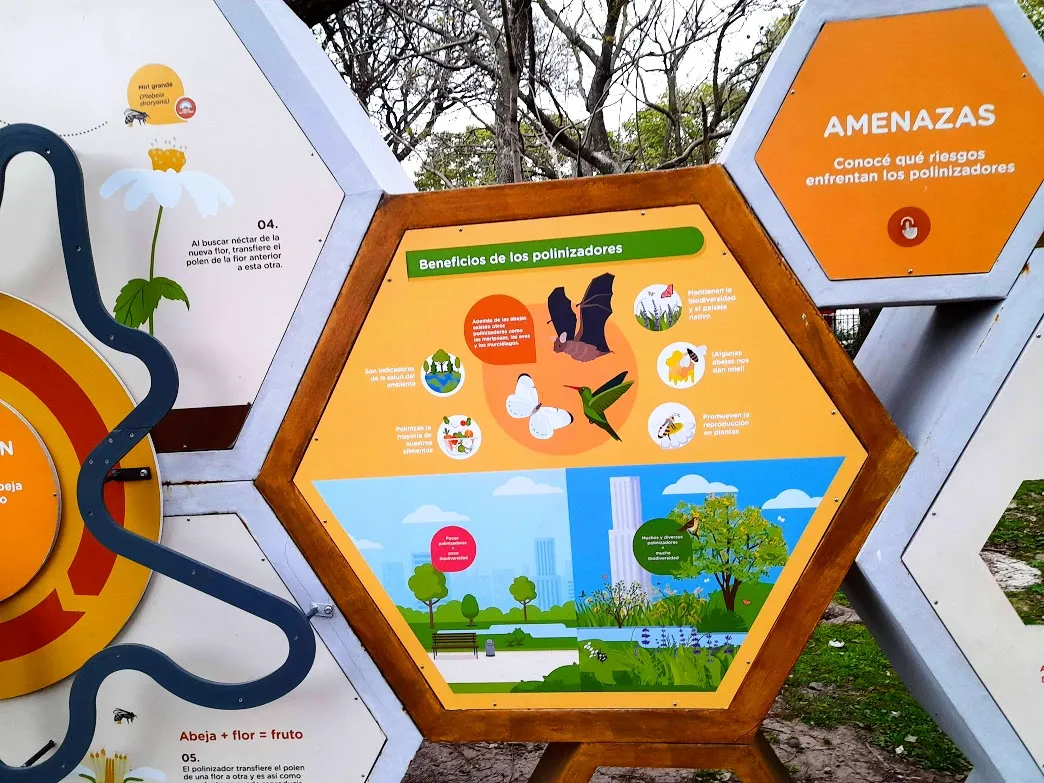
Luego continúa el juego describiendo los riesgos que enfrentan los polinizadores y la manera de afrontarlos. Son datos importantes y están ilustrados. Estos datos, a medida que los jugadores descubren unas ventanas, encuentran las respuestas adecuadas.
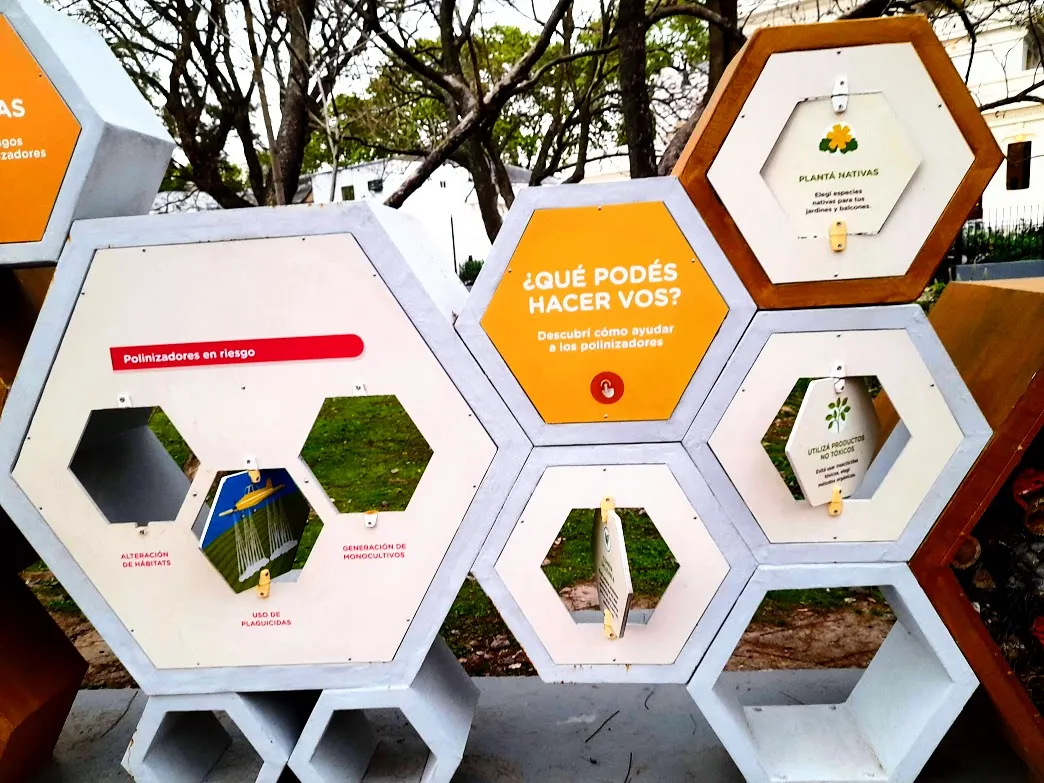
Para finalizar este trayecto tan hermoso, sobre la vida de insectos, cómo es la polinización, a través del juego interactivo y al aire libre. Veremos un HOTEL DE INSECTOS. Este es un hotel inspirado en la estructura del panal de las abejas. Este hotel dividido en celdas, es visitado por una gran diversidad de insectos, dependiendo de la época del año. Allí encuentran su refugio y permanecen hasta que llega su tiempo de salir a polinizar. Cada celda contiene diverso tipo de material, como trocitos de madera, plantas secas, semillas, carbón orgánico, etc.
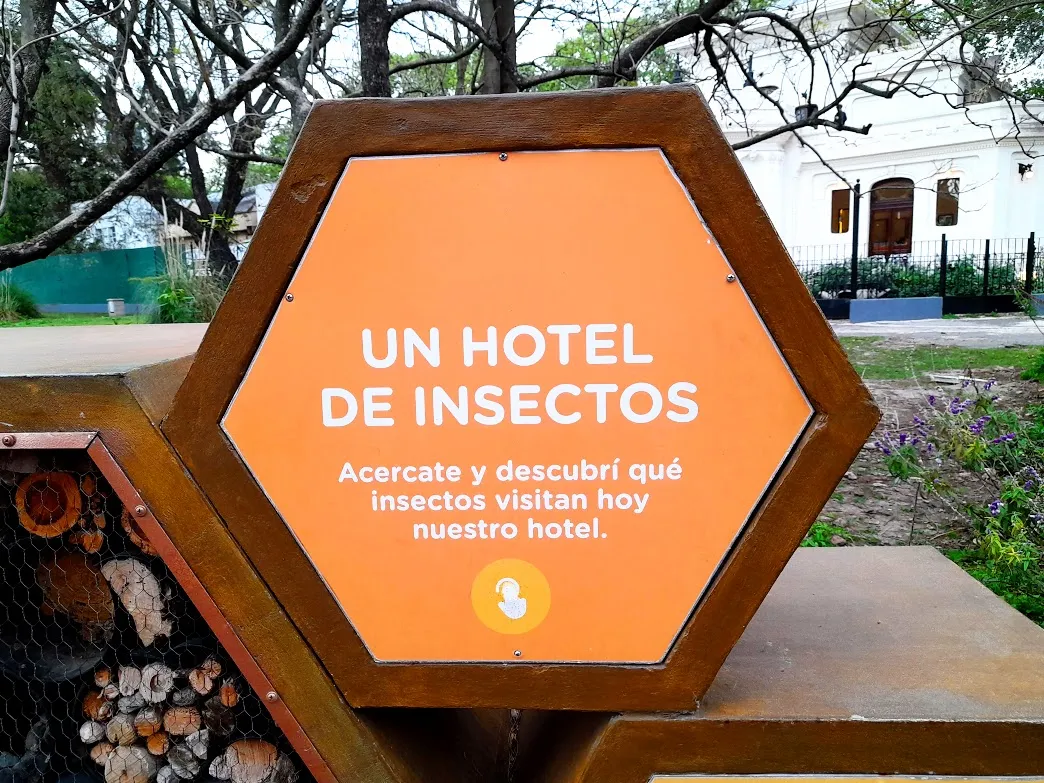
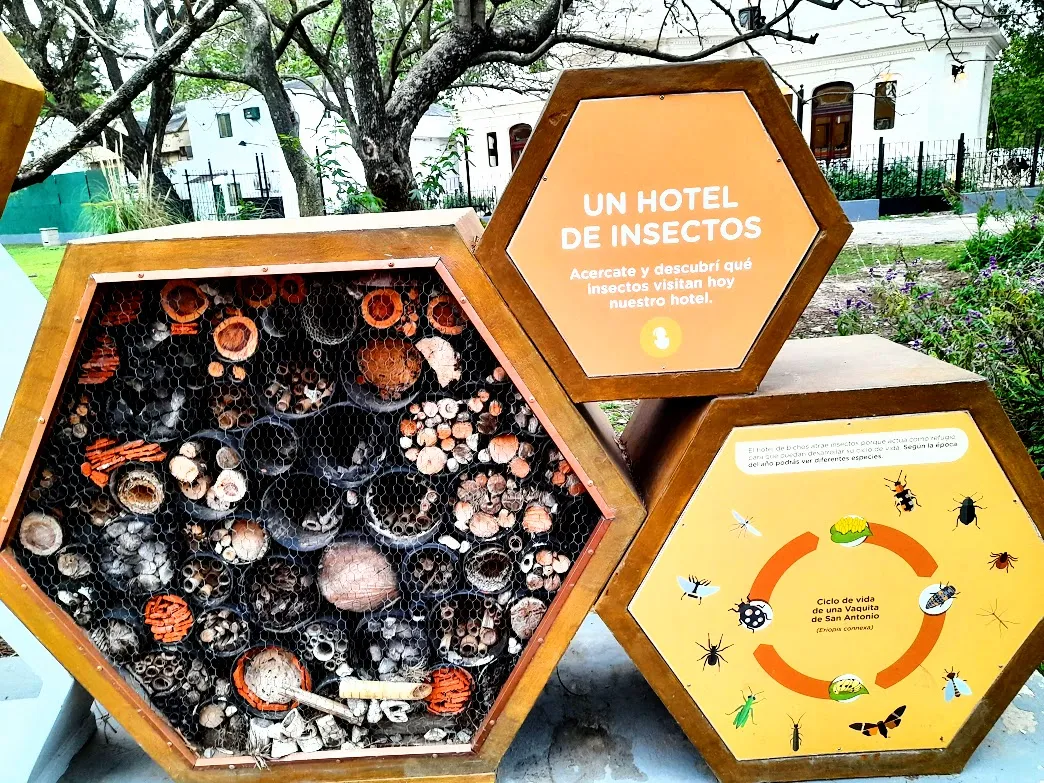
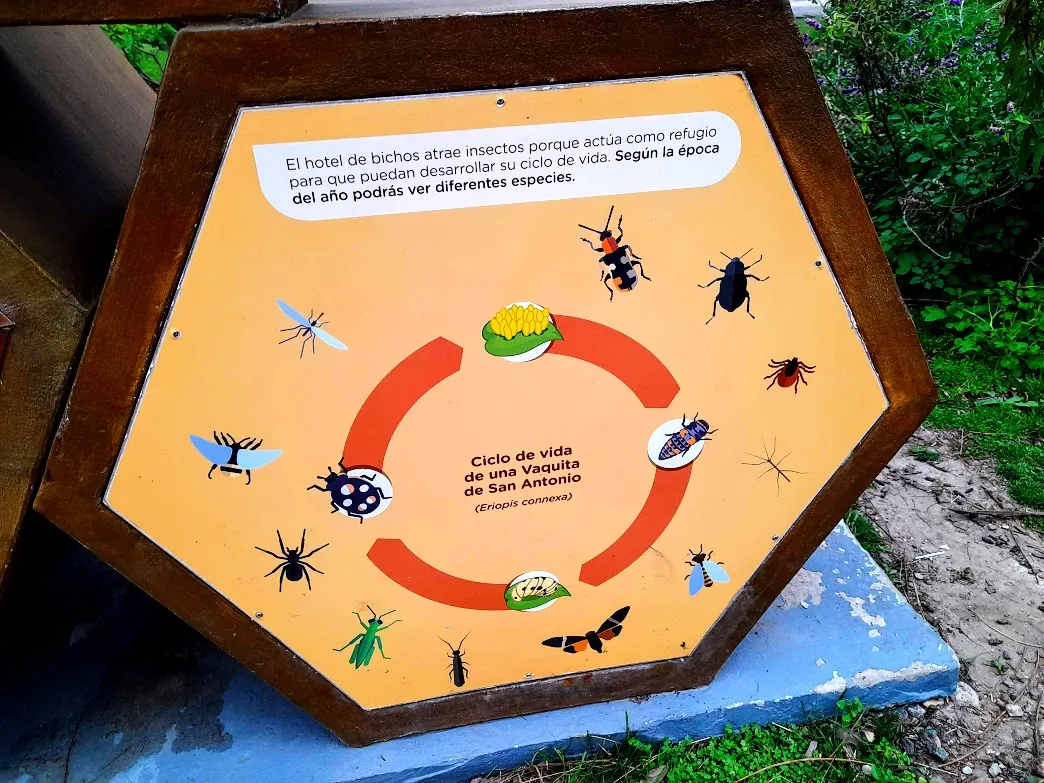
Para cerrar este tipo de juego educativo, tenemos en el espacio una réplica de un gran panal, en el que se explica qué son las abejas, su importancia y las razones por las que debemos protegerlas. Este panal tiene cuatro celdas y en ellas hay cuatro especies autóctonas. Podemos verlas a continuación. Estas fotos no eran tan claras, porque tienen un cristal y eran opacas. Pero al menos podemos ver cada especie. La lupa está ahí para que la usen los niños y los que no saben leer a simple vista.
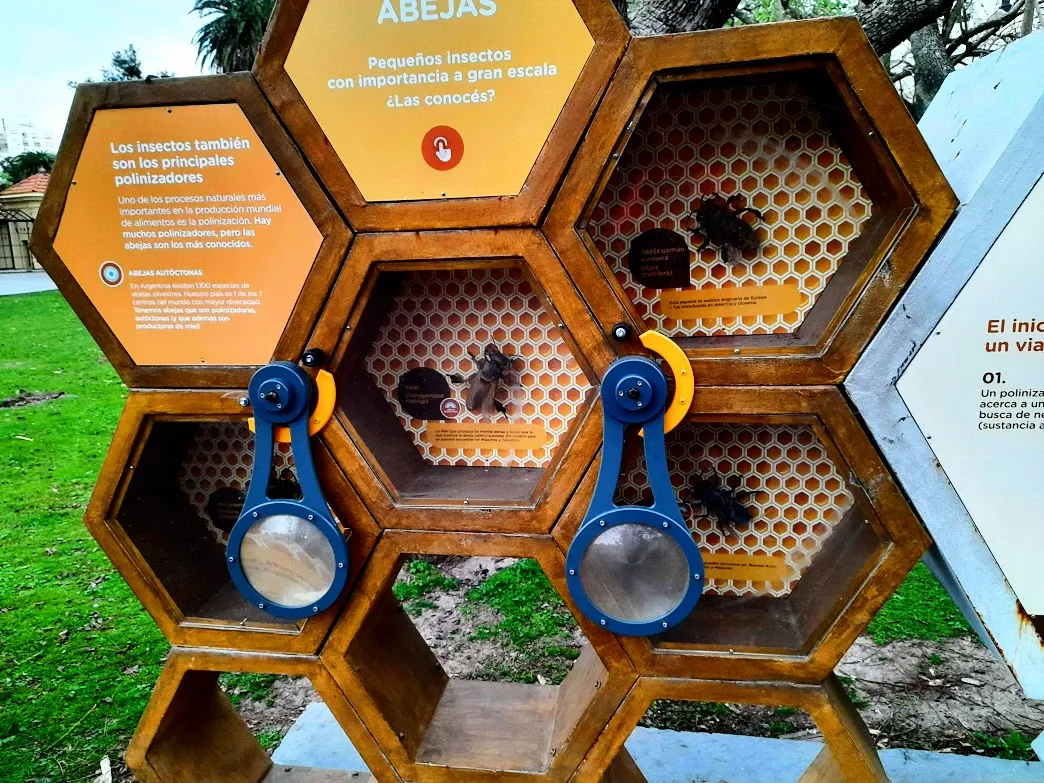
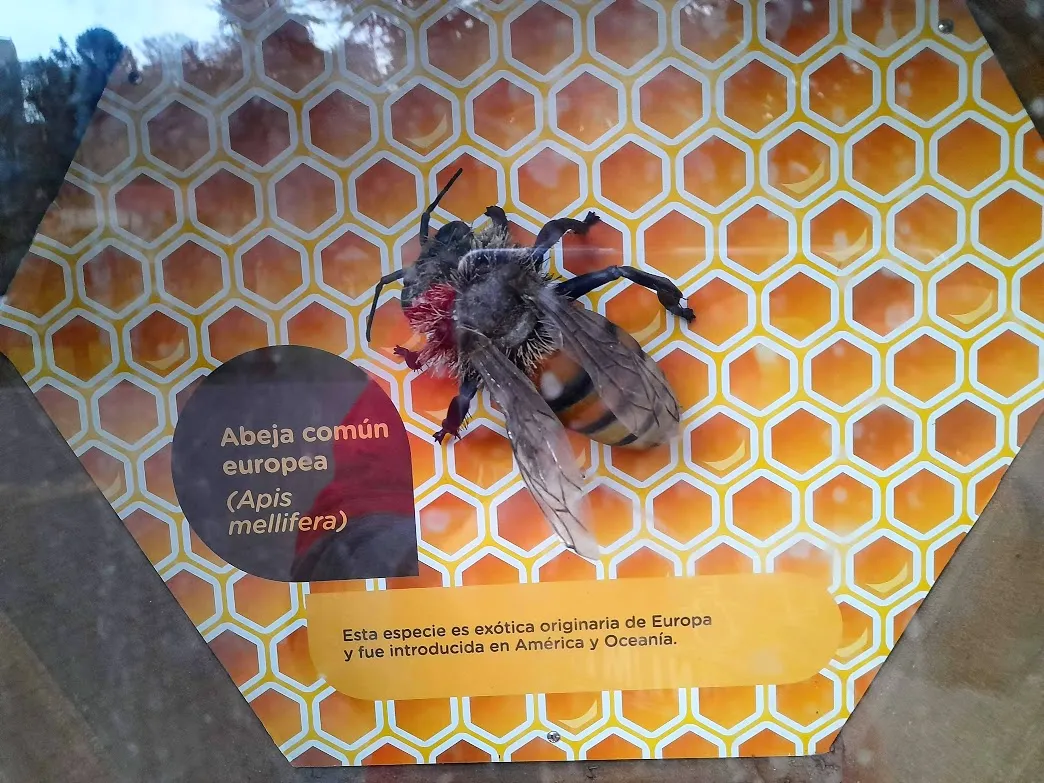

Este tipo de juegos didácticos al aire libre, sirven para obtener aprendizaje a través de la recreación. Si tomamos en consideración los conocimientos previos que posea cada jugador, hasta se podría concluir que se ha obtenido un aprendizaje significativo, por lo bien planificado y bien estructurado del mismo. En el Eco Parque de la ciudad de Buenos Aires, están promoviendo este tipo de juegos, no solo con esta especie, sino en otras áreas y un poco más complejos. Espero les haya parecido tan interesante como a mí.
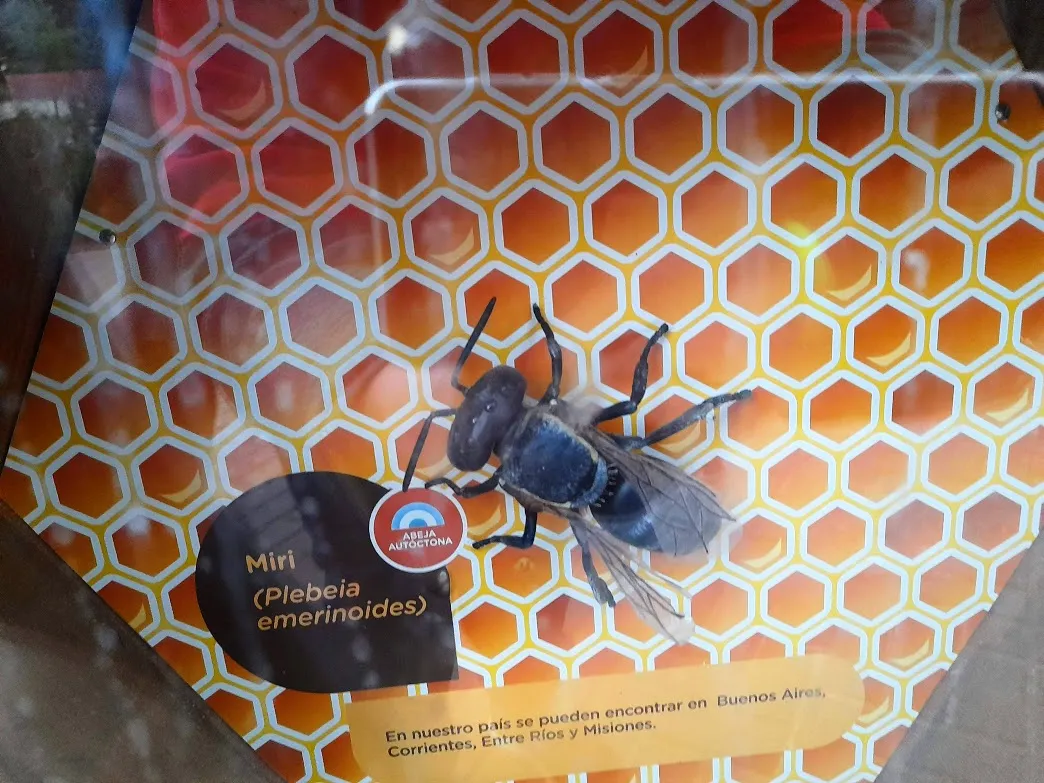
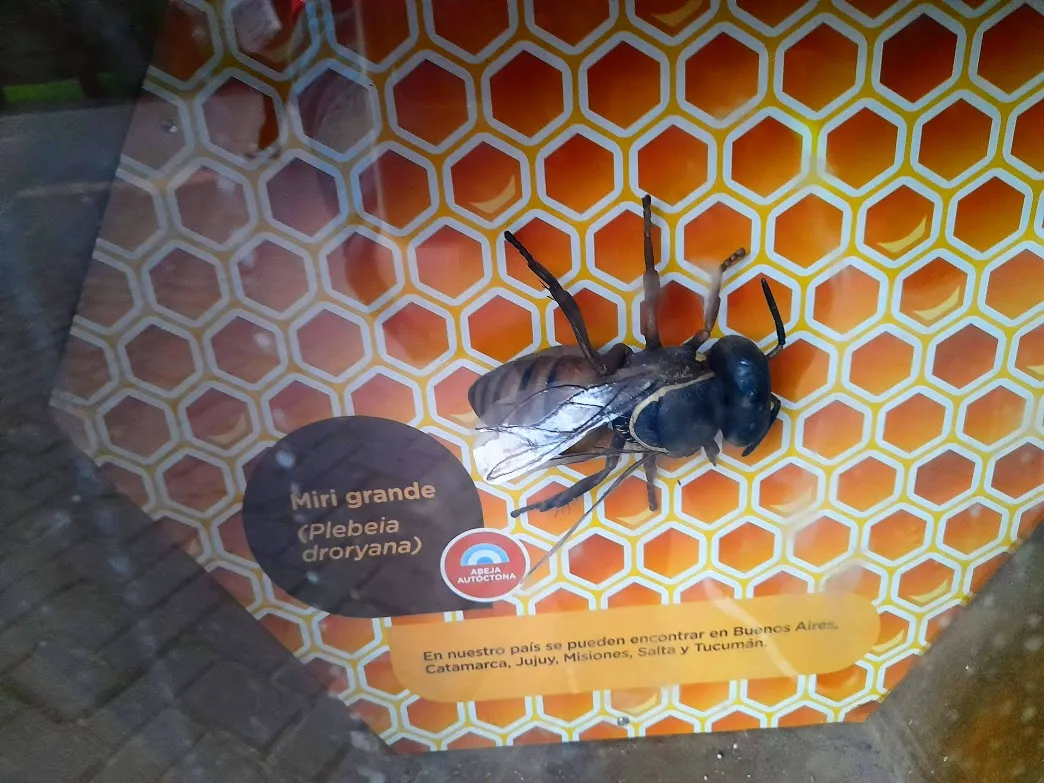
No perdamos las ganas de jugar, de compartir, de vivir experiencias lindas y nuevas, y si esa diversión nos va a llevar a tener un mejor ecosistema, pues, vayamos todos a jugar.
ENGLISH

During my last visit to the Buenos Aires Ecopark, I could not leave unnoticed a space that has been built so that both children and adults have the opportunity to learn all about pollination, care and benefits of bees and other insects. I have placed as title "Knowing the bees through interactive game", because that is one of the most effective strategies when it comes to imparting some kind of teaching. In this case, both children and adults can exchange roles, and exercise them as well. While playing, all previous knowledge is activated, especially those that may have been mistaken and that, thanks to this activity, would be clarified and learned.

It is a giant honeycomb, where each person can participate by taking one of the bees by the hand to go through the actual pollination process. The structure is designed to facilitate the process and the interaction of all those who wish to learn. I will now explain each of the images and the strategy to lead the player to the achievement of cognitive learning.

The following image shows the size of the game's guide bee. With it, you will follow the path, step by step, until you reach the end of this process.
Step 1: The pollinator approaches the flower containing the nectar.
Step 2: When it gets the nectar, it is impregnated with the flower's pollen.
Step 3: It continues its journey from flower to flower, carrying its pollen-filled body.
Step 4: Carrying the pollen in its body, when it passes to the next flower, it impregnates it with pollen as well.
Step 5: In this exchange of pollen, the pollinator, by transferring pollen from one flower to another, makes it possible for the plant to reproduce.
Step 6: The success of this pollination process is that the plants can finally generate their fruits and seeds.
Well, up to this point, one part of the game is over. As demonstrated, it is a strategy that will lead the person to achieve "meaningful" learning. In addition to internalizing the importance of the work of bees and other insects in carrying out this work, which is so necessary for the balance of the planetary ecosystem.

The next aspect to be discussed in the same game is the benefits of pollinators. As we know, and here they explain it with illustrations, not only bees are pollinators. In the lower part of this image they represent with two landscapes, what the consequences of no pollination mean, such as less biodiversity and less pollinators. Now what happens when nature is left to act freely, there are many pollinators and abundant biodiversity.

Then the game continues by describing the risks faced by pollinators and how to deal with them. These are important facts and they are illustrated. These facts, as the players discover some windows, find the appropriate answers.

To end this beautiful journey, about insect life, how is pollination, through interactive play and outdoors. We will see an INSECT HOTEL. This is a hotel inspired by the structure of the honeycomb of the bees. This hotel, divided into cells, is visited by a great diversity of insects, depending on the time of the year. There they find their shelter and stay until it is time for them to leave to pollinate. Each cell contains different types of material, such as wood chips, dried plants, seeds, organic charcoal, etc.



To close this type of educational game, we have in the space a replica of a large honeycomb, which explains what bees are, their importance and the reasons why we must protect them. This honeycomb has four cells and in them there are four native species. We can see them below. These photos were not so clear, because they have a glass and were opaque. But at least we can see each species. The magnifying glass is there for children and those who can't read with the naked eye to use.



This type of outdoor didactic games serve to obtain learning through recreation. If we take into consideration the previous knowledge that each player has, we could even conclude that a significant learning has been obtained, due to its well planned and well structured. In the Eco Park of the city of Buenos Aires, they are promoting this type of games, not only with this species, but in other areas and a little more complex. I hope you found it as interesting as I did.


"Let's not lose the desire to play, to share, to live beautiful and new experiences, and if this fun will lead us to have a better ecosystem, then let's all go and play"
Gracias por su visita. Thank you for your visit
Todas las fotografías pueron capturadas con mi Samsung, A-12.
All photographs were captured with my Samsung, A-12.
Traducción
X